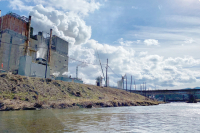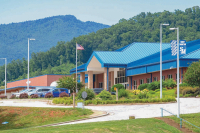Maggie Valley mudslide lands in court
 A lawsuit casting blame for a massive landslide in Maggie Valley four years ago is headed to a jury trial in Haywood County this week.
A lawsuit casting blame for a massive landslide in Maggie Valley four years ago is headed to a jury trial in Haywood County this week.
A couple whose home was in the path of the landslide have sued a bevy of parties they claim are responsible.
Chiefly, they fault two sets of engineers and graders behind an extensive retaining wall that snaked a few hundred feet across the face of the mountain above their home. The suit claims the retaining wall was subpar and its collapse is what triggered the landslide — and further, that the risk of the retaining wall’s failure was known but not revealed.
“A year before the slide, this thing was showing signs of failure,” Attorney Matthew Roberson, who is representing the couple, said in court Monday. “You have Buck Mountain getting bored out by a massive landslide and our client’s house being struck by a massive wall of mud as a result.”
In addition to blaming the engineers and graders who built the wall, the suit names Ghost Town in the Sky, a mountaintop amusement park with chronic slope stability problems over the decades.
The suit accuses Steve Shiver, the former manager of Ghost Town in the Sky, of being inattentive at best to the threat posed by the strained retaining wall — and at worst, intentionally turning a blind eye to the looming risk to downslope neighbors.
Related Items
Meanwhile, the engineers and builders behind the wall claim there’s no way to know what caused the landslide.
“The problem with this case is this whole mountain came down,” Bill Jones, an attorney for engineer Verlin Edwards, said in court Monday.
Jones proffered a chicken-and-egg conundrum. Did the landslide knock out the wall, or the wall fall and cause the landslide?
“Did it start at the wall? Did it start below the wall? To testify on the cause of the failure would be speculation and conjecture,” Jones said.
Such a deep bench of people being sued — six individuals in all — means a lot of lawyers in the kitchen. There were so many lawyers trying to pack in behind the defendant’s table this week, they couldn’t all fit.
At the start of proceedings Monday, three of them took off down the hallway and returned a moment later, each wheeling an extra chair. Once they were settled, a row of seven lawyers snaked around the defendants’ table and along the wall, with boxes and giant binders of case files and exhibits mounded around them.
The attorney for the homeowners doing the suing seemed awfully outnumbered on the other side of the room.
Pretrial motions in the case were heard before Superior Court Judge William Coward on Monday. Jury selection was slated to begin Tuesday, and once a jury is seated, the trial could take two to three weeks.
The suit was filed in 2012. An attempt to reach a settlement during mediation was unsuccessful.
Adding to the courtroom mystique this week, one of the more high-profile people being sued has been a no-show so far.
Ghost Town’s former manager Steve Shiver, who skipped town after the park went bankrupt with a trail of bad debt, angry investors and unpaid bills, has been MIA during the nearly three years of legal filings and paperwork posturing between parties in the case. Shiver hasn’t responded to the suit and doesn’t have a lawyer defending him. He was listed by default as representing himself, but he hasn’t shown up to do that either.
A tangled web
The various defendants — the suit names five engineers and builders plus Ghost Town’s former manager — have postulated various defenses.
A universal favorite is that natural causes were to blame for the slide, a so-called “act of God” in legal terms.
But, to be on the safe side, the two sets of engineers and builders have pointed fingers at each other in a series of cross-claims, third-party suits, counter claims to the cross claims and various legal wranglings.
Two different crews of engineers and graders were hired at different times between 2007 and 2009 to tackle slope stability issues at Ghost Town — stemming from a 40-year-old railroad tie retaining wall that was in disrepair and prone to blowing out in places.
This was no run-of-the-mill retaining wall. It stretched for 380 feet and reached up to 40 feet high. Shoring it up required rebuilding an 80-foot section, plus building a brand-new wall that ran its full length and was about 25 feet high.
The first stab at fixing the wall was in 2007. Verlin Edwards, an engineer from Maggie Valley, was hired to oversee the work, and Burton Edwards, a grader from Maggie and Verlin’s nephew, was the contractor. The suit also names Colin Edwards, Burton’s cousin and Verlin’s son, who was an equipment operator on the job.
A year-and-a-half later, a second crew was called in to shore up the wall once more, this time Pat Burgin, an engineer from Waynesville, and grader John Caldwell.
Verlin and Burton Edwards claim this subsequent work undermined the stability of their original wall, and if the wall failed, it was Burgin and Caldwell’s tinkering that caused it, according to court filings.
Meanwhile, Burgin claims the wall built by Verlin and Burton Edwards was “not functioning as intended and structural failure of the wall is possible if not replaced.” Burgin also claimed the work by Caldwell attempting to fix problem spots was “inadequate” and “improperly constructed” and it “was destined to fail,” according to court filings.
Burgin was originally recruited as an expert witness for the couple who filed the lawsuit, but he ultimately got dragged into the suit as a defendant himself.
Caldwell claimed he was just a hired hand paid by the hour and did what Ghost Town’s general manager Steve Shiver told him to do, according to a deposition.
Meanwhile, Colin Edwards claims he was just a hired laborer for his cousin Burton Edwards — “I basically hauled dirt,” Colin said in his deposition — and thus isn’t responsible for any failings of the wall.
Damages
The couple who filed the suit, Kurt Bielder and Tammy Jones, weren’t injured in the landslide, nor was their home destroyed. While their yard was ravaged, their house was only side-swiped by the slide.
But it was enough to bust one wall and shift the house on its foundation, which coupled with irreparable damage to the septic drain field has rendered the house unlivable, according to their suit.
In addition to monetary compensation for their damaged home, the couple is seeking damages for emotional distress. Jones has post-traumatic stress syndrome, including bouts of crying, sleeplessness and depression, her attorney Matthew Roberson said in court on Monday.
In the suit, Jones describes being home alone in her living room at night on the evening of Feb. 5, 2010, when a loud crashing noise grew closer and closer, accompanied by shaking and vibrating.
“The debris flow was 3,000 feet long and 90 feet wide and created a wave of mud and debris some 30 feet high. The mudslide destroyed virtually everything in its path,” the suit states.
“In the darkness, Tammy Jones had to remove mud, limbs and wood to escape from the home. She feared for her life, that her home could collapse and additional mudslides would occur,” the suit states.
Attorneys defending the accused engineers and graders include Bill Jones, Burton Smith and Rusty McLean of Waynesville; Garry Davis, Luke Sbarra and Ben Chesson of Charlotte; and Robert Allen of Asheville.
The story of the Ghost Town retaining wall
Slope slippage had been an Achilles’ Heel for Ghost Town in the Sky amusement park in Maggie Valley over the years.
When the mountaintop was leveled off to build Ghost Town decades ago, dirt was pushed off, heaped up and piled over the side, apparently without being properly compacted. Gravity has been getting the best of it bit-by-bit ever since.
A civil suit filed by a couple who live below Ghost Town claim a massive landslide in 2010 that damaged their yard and home was due to the negligence of Ghost Town and the various engineers and graders hired between 2007 and 2009 to build and shore up retaining walls at the top of the mountain.
Here’s a timeline of the recent slope work and retaining walls at Ghost Town:
Fall 2007 - Spring 2008
An old railroad tie retaining wall dating to the 1960s or ‘70s that was 40 feet high in places no longer seems up to the job of holding back the mountainside below Ghost Town, witnessed by a “number of blow-outs,” according to court filings. Steve Shiver, general manager of Ghost Town at the time, hires a team to “stabilize an old crosstie retaining wall which had fallen into a state of disrepair and was in danger of failing,” according to court filings.
Verlin Edwards of Maggie Valley serves as the engineer that oversees the job. Burton Edwards, a Maggie Valley grader and Verlin Edwards’ nephew, is the main contractor. Colin Edwards, Burton’s cousin and Verlin’s son, is hired by Burton as a laborer to help with the job.
The work includes rebuilding an 80-foot-long by 40-foot-high section of the original wall, plus building a new wall that’s 380 feet long by 25 feet tall, running along the base of the existing wall to shore it up and buttress it in place. The price tag for the job is estimated between $312,000 and $377,000, according to the contract.
2009:
“Members of Ghost Town Partners observed what they believed to be new signs of distress in the soils around the retaining wall,” court filings state. Engineer Pat Burgin of Waynesville is hired to assess the walls — both of the new walls that were built and the original wall that’s still there. Burgin determines it is “not functioning as intended at this time and structural failure of the wall is possible if not replaced,” according to court filings. Burgin designs a fix and grader John Caldwell was hired to do the work, which included removing some of the soil load being held back by the wall and cutting off the top of the wall to make it shorter.
Jan. 10, 2010:
A massive landslide rocks down the mountain, appearing to originate from the retaining wall, which has busted apart at the head of the slide. Homes are evacuated. No one was injured.
2012:
A couple who lived in the path of the slide file a lawsuit against all the above named parties.













